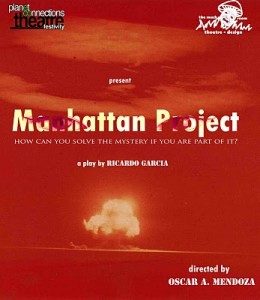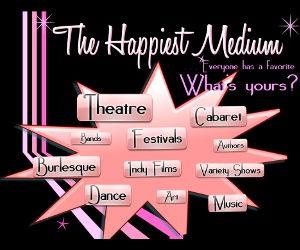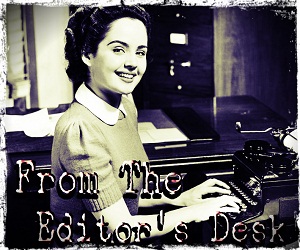
“The Manhattan Project” was the code name for the research and development of the atomic bomb between 1942 and 1946. The project’s early manifestations did occur in Manhattan, but the project would later expand to about 30 different locations in the U.S., Canada and the U.K. and employ over 130,000 people.
One could assert that there are two kinds of people in this world: Those of a perhaps morose disposition who know seemingly erudite specifics about the making and dropping of the atomic bomb and those who don’t.
Manhattan Project, written by Ricardo Garcia and directed and designed by Oscar A. Mendoza, would also make binary assertions: Events are either predictable or unpredictable, mathematical or chaotic, physical or linguistic, which is to say, tangible or intangible. Even the medium of the play is divided in two—film and theatre.
The play begins on film. First, some actual footage brings the audience up to speed on exactly what happened in Hiroshima on the morning of August 6, 1945. Cut to a filmed segment of the play: an interview between a male writer (Jeffery Steven Allen) and a female physicist (Barbara Mundy) who worked on the atomic bomb at Los Alamos. As the writer probes into the physicist’s feelings about the bomb, the writer ends up tells her about an idea he has for a story in which a man would kill a woman. Cut to the theatre component of the play. The lights brighten on the set to reveal a loaf of bread, a knife and a basket of fruit on a small table. A young man and a young woman approach each other.
The writer’s story is about a married couple that worked on the final stages of the atomic bomb at Los Alamos. On the day of the atomic bomb would be tested in the desert of New Mexico, as the couple is preparing a picnic to go watch the explosion, the man, Charles (Paul Daily), accuses his wife, Margaret (Danielle Patsakos), of cheating on him with Enrico (Christopher Diaz). He accuses. She denies. He accuses, again, and she denies, again. Accusation. Denial. Assertion and rejection. Male and female. Truth and fiction.
The initial binaries established during the conversation between the writer and the physicist on film that had risked platitudinous abstractions were becoming more complex in the scenes enacted from the writer’s story-in-progress. Interesting questions began to arise: How can we begin to fathom war when we can barely cope with personal strife? How much power does one person really have over his or her own life, what to speak of his or her historical context? How do we live our daily lives in the face of global tragedy? Is it inhuman to approach war scientifically? How do we approach the topic of war artistically? Why? These questions remain, especially these days, quite relevant.
The project of Manhattan Project is perhaps to remind us that however we approach human events—analytically or creatively—the fact is that people are always lost in global conflict. 80,000 lives in Hiroshima, and 50,000 in Nagasaki a few days later—with their loves and infidelities, with their cut bread and their glasses of wine—were stopped in an instant. And more painful deaths would follow.
Manhattan Project is a play for the morose, because they can’t look away, and for the happy-go-lucky, because they’d rather. The interplay between film and theatre is an interesting comment on how normal civilians experience war. The acting is, for the most part, quite engaging, and, I should mention, the music hits a perfect note and tone for the play. Where the direction seems a little heavy-handed at times, or contrived, the provocative themes of the play make up for these relatively small shortcomings.
So, one could say that are two kinds of people in this world: Those who know that Paul Tibbets, the pilot who flew the plane that dropped the first atomic bomb, on Hiroshima, named the plane Enola Gay after his mother, and those who don’t. And maybe these details aren’t erudite but are crucial in making our actions more real to us. Manhattan Project is a play worth seeing; it creatively utilizes specifics to illuminate conflict on the smallest and largest scales, which, in turn, makes this nuclear age less abstract in our minds. (“Little Boy” was the name of the bomb.)
~~~
MANHATTAN PROJECT A Mush-room Theatre Design production benefiting Coalition for the Homeless Written by Ricardo Garcia Translated by Adolfo Perez Alvarez Directed and Designed by Oscar A. Mendoza Musical Direction: Xavier Paez Haubold Venue: The Robert Moss Theater, 440 Lafayette Street, 3rd floor Performance dates: Sun 6/6 @ 1pm Mon 6/7 @ 6:30pm Fri 6/11 @ 9pm Sun 6/13 @ 3pm Sun 6/20 @ 1:15pm Wed 6/23 @ 6:30pm Purchase tickets here






{ 0 comments… add one now }